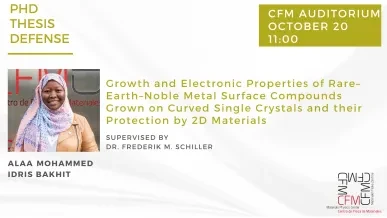PhD Thesis Defense | Alaa Mohammed Idris Bakhit
Alaa Alaa Mohammed Idris Bakhit
CFM
CFM Auditorium

CANDIDATE: Alaa Mohammed Idris Bakhit
SUPERVISOR: Dr. Frederik M. Schiller
As the semiconductor industry approaches the limits of Moore’s Law, this work investigates novel material platforms to address future demands. This PhD thesis explores the design and stabilisation of two-dimensional (2D) ferromagnetic surface alloys, through the intercalation of europium (Eu) beneath a protective monolayer of hexagonal boron nitride (hBN) on various transition-metal (TM) substrates. By combining experimental techniques, including low energy electron diffraction (LEED), scanning tunnelling microscopy (STM), x-ray photoelectron spectroscopy (XPS), angle-resolved photoemission spectroscopy (ARPES), x-ray magnetic circular dichroism (XMCD), and near-edge x-ray absorption fine structure (NEXAFS) with Density Functional Theory (DFT) simulations, the study examines structural, electronic, and magnetic properties across both flat and curved (vicinal) surfaces such as Pt(111), Ir(111), Pd(111), Ru(0001), Rh(111) and Ni(111).
The structural characterisation of hBN grown on flat and curved TM crystals revealed that substrate orientation and lattice mismatch critically influence hBN growth, surface faceting, and bonding strength, with insights supported by DFT calculations. hBN growth was found to induce faceting in all studied systems. For strongly interacting systems, only a few stable facets were observed, such as in the hBN/c-Ni(111) system, while weakly interacting systems exhibited more stable facets, exemplified by the hBN/c-Pt(331) system. A special case of Pt was further explored through DFT to provide a deeper understanding of these findings.
The experimentally observed stable facets displayed local covalent bonding in DFT calculations, in contrast to the unstable facets. The adsorption energies obtained for unstable facet systems were lower than those of stable facet systems. Despite computational limitations, our results are qualitative to some extent, but they also provide valuable insight into the formation of stable facets. Upon Eu intercalation below the hBN on curved TMs substrates, the previously observed stable facets changed. A strong hBN/EuTM$_{2}$ interaction was detected from the shift of the core-level spectra of N 1s and B 1s in XPS and confirmed by the ARPES analysis, which showed a downward shift of the hBN $\pi$ band.
One of the key findings includes the formation of ordered EuPt$_2$ and EuRh$_2$ surface alloys protected by hBN, confirmed by $(\sqrt{3} \times \sqrt{3})R30^{\circ}$ superstructure, predominantly divalent Eu signal in XPS, and strong ferromagnetic ordering with Curie temperature of 14.1 K for EuRh$_2$ as demonstrated by XMCD. hBN provided partial oxidation protection in all systems, especially in c-Pt(111) at (111) and, surprisingly, in c-Ni(111) away from (111).
Additionally, the thesis demonstrates that hBN-graphene hybrids (hBNC) can be tailored by controlling growth temperature and step density to engineer their electronic properties. Moreover, the substrate material also plays a crucial role in the hBNC growth.
Overall, this research establishes a framework for engineering air-stable, scalable 2D ferromagnetic systems that can integrate Eu-TM alloys and hBN, offering a promising pathway towards next-generation spintronic devices.
